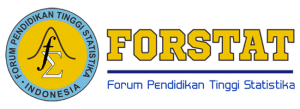Analisis Model Matematika Penyebaran Demam Berdarah Dengue dengan Fungsi Lyapunov
(1) Jurusan Matematika, Fakultas Matematika dan Ilmu Pengetahuan Alam, Universitas Negeri Makassar, 90224
(2) 1Jurusan Matematika, Fakultas Matematika dan Ilmu Pengetahuan Alam, Universitas Negeri Makassar, 90224
(3) Jurusan Matematika, Fakultas Matematika dan Ilmu Pengetahuan Alam, Universitas Negeri Makassar, 90224
(*) Corresponding Author
DOI: https://doi.org/10.35580/jmathcos.v1i2.9188
Abstract
Abstrak. Artike lini adalah penelitian teori dan terapan. Artikelini bertujuan untuk membahas mengenai model matematika SIRS untuk penyebaran Demam Berdarah Dengue. Data yang digunakanadalah data sekunder jumlah penderita penyakit Demam Berdarah Dengue dari Side pada tahun 2014. Pembahasan di mulai dari membangun model matematika SIRS penyakit Demam Berdarah Dengue, menentukan eksistensi model SIRS menggunakan fungsi Lyapunov, penentuan titik ekuilibrium, kemudian mencari analisis kestabilan titik ekuilibrium menggunakan fungsi Lyapunov, menentukan nilai bilangan reproduksi dasar , membuat simulasi model, dan menginterpretasikannya. Dalam artikel ini diperoleh model matematika SIRS untuk penyakit Demam Berdarah Dengue, eksistensi model SIRS, dua titik ekuilibrium bebas penyakit dan endemik dari model SIRS, kestabilan global keseimbangan bebas penyakit dan endemik dari model SIRS dengan nilai bilangan reproduksi dasar , ini menunjukkan bahwa penyakit Demam Berdarah Dengue berstatus epidemik.
Kata Kunci: Model Matematika, Penyebaran Penyakit, Demam Berdarah Dengue, Model SIRS, Fungsi Lyapunov
Abstract. This paper is theorethical and applied research. This paper aims to discus about SIRS mathematical models for the spread of dengue fever. The data used is a secondary data about the number of people with dengue fever disease from Side (2014). The discussion start from constructing SIRS models of dengue fever disease, determining the existence of SIRS models using Lyapunov function, determining equilibrium point, then looking for stability analysis of equilibrium point using Lyapunov function, determining reproduction number , making models simulation, and interpreting it. In this paper, we obtained mathemathical models of SIRS for dengue fever disease, existence of SIRS models, disease-free and endemic equilibrium points of SIRS models, global stability of disease-free and endemic equilibrium of SIRS models with basic reproduction number , it shows that dengue fever disease is epidemic status. , This shows that Dengue Hemorrhagic Fever is an epidemic.
Keyword: Mathematical Model, Spread of Disease, Dengue Fever, SIRS Model, Lyapunov Function
Full Text:
PDFReferences
Maesaroh, U. (2013). Model Matematika Untuk Kontrol Campak Menggunakan Vaksinasi.Universitas Islam Negeri Sunan Kalijaga, Yogyakarta.
Roni, T.P. (2011). Kestabilan Lokal Bebas Penyakit Model Epidemi SEIR dengan kumpulan Infeksi pada Periode Laten. Politeknik Negeri Padang, Padang.
Rohmah, N. & Kusumaniwahyu, W. M. (2014). Dinamik Model Epidemi SIRS dengan Laju Kematian Beragam.Jurnal Matematika Integratif, 10(1). 1-7.
Ginting, I. (2014). Teori Kestabilan Lyapunov. http://digilib.itb.ac.id/gld.php?mod=browse&op=read&id=jbptitbpp-gld-iwangintin-19415 diakses pada tanggal 9 Oktober 2016.
WHO. (2009). Fact sheets: dengue and dengue haemorrhagic fever’ [online] http://www.who.int/mediacentre/factsheets/fs117/en/
Kompas. (2016). Benarkah Kebal Virus DBD Jika Sudah Pernah Kena?. http://health.kompas.com/read/2016/05/03/120000823/Benarkah.Kebal.Virus.DBD.jika.Sudah.Pernah.Kena .diakses pada tanggal 9 Oktober 2016.
Side, S. (2014). Pemodelan Matematika SIR dan SEIR.Makassar: Badan Penerbit Universitas Negeri Makassar.
Campbell, S. L., & Haberman, R. (2008). Introduction to Differential Equations with Dynamical System. New Jersey: Princeton University Press.
Perko, L. (2001). Diffrential Equations and Dynamical System 3rd. New York: Springer.
Olsder& Woude, V. D. (2004). Mathematical System Theory. Belanda: Deflt Univercity of Technology.
Anton, H.(2000). Dasar-dasar Aljabar Linear. Batam: Interaksara.
Mulisi, S.(2011). Pengaruh Vaksinasi Terhadap Dinamika Populasi pada Model SIR (Suspected-Infected-Recovered). Institut Pertanian Bogor, Bogor.
Luenberger, D.(1979).Introduction to dynamical system theory, models, and applications.Canada: John Wiley & Sons, Inc.
Article Metrics
Abstract view : 2270 times | PDF view : 362 timesRefbacks
- There are currently no refbacks.
Copyright (c) 2019 Journal of Mathemathics, Computation, and Statistics
Indexed by:

This work is licensed under a Creative Commons Attribution-NonCommercial-ShareAlike 4.0 International License.











